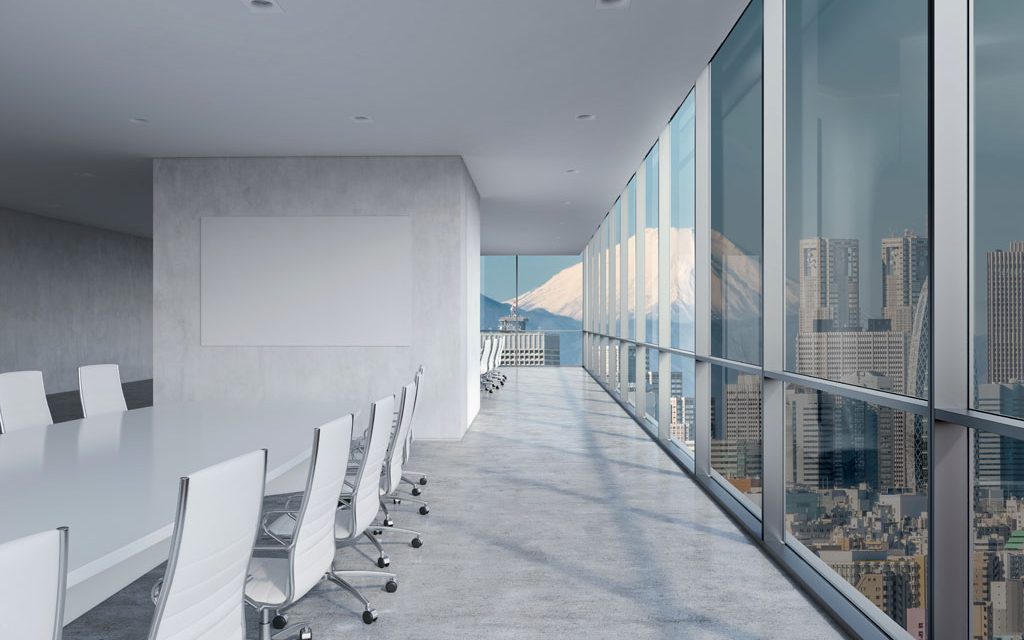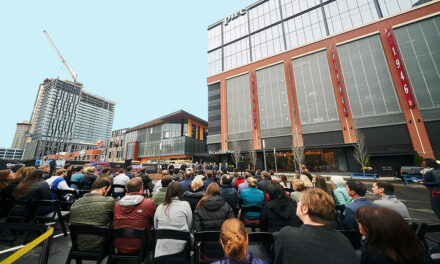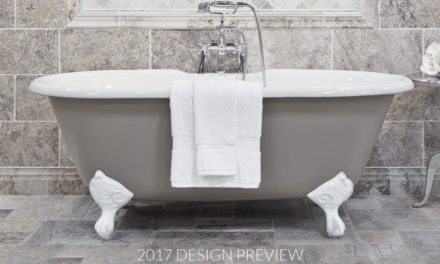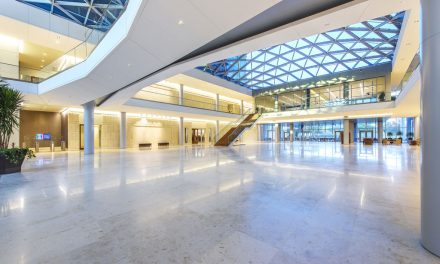We typically spend 90% of their time indoors, though our biology causes us to crave a connection to the outdoors and the natural light. This is one reason why we want as many windows as possible. Yet according to the Urban Green Council, 75% of windows, whether commercial or residential, are covered by curtains, shades or blinds that are at least half drawn, no matter the time of day.
Advances in electrochromic technologies have given building owners new options for maintaining their views and daylight, which studies have shown to boost vitality, productivity, and improve sleep by helping people keep in sync with their circadian rhythms. When used to block the sun’s heat and admit daylight, electrochromic or smart-tinting glass has been proven to reduce the energy used for air conditioning and electric lighting, providing as much as 20% in energy savings over low-E glass.
In fact, smart-tinting glass can provide solar shading and daylighting control similar to mechanically dynamic facades, without the maintenance requirements of motors, levers, and bearings. As with all technologies, major strides have been made to improve smart glass especially with electrochromic glass, in the areas of tinting speed, tinting uniformity, and tint color. And its adoption is growing: Allied Market Research recently projected that the smart glass category will reach nearly $7 billion by 2022.

Credit: Kinestral Technologies
So which smart glass technology is best for your project? The right choice depends on the needs of the builder and tenants. Some areas to consider include:
- Are you only looking for privacy? Or do you want to cut glare and control solar heat as well?
- Is this an internal application or an externally facing one?
- Do you want to automate the functionality? Do you want to provide manual override control to building occupants?
Smart glass has become a catch-word for the many “smart glass” technologies on the market. Here’s a brief introduction to the benefits and drawbacks of each. The most technically advanced, electrochromic glass, gives complete control over every aspect of natural light.
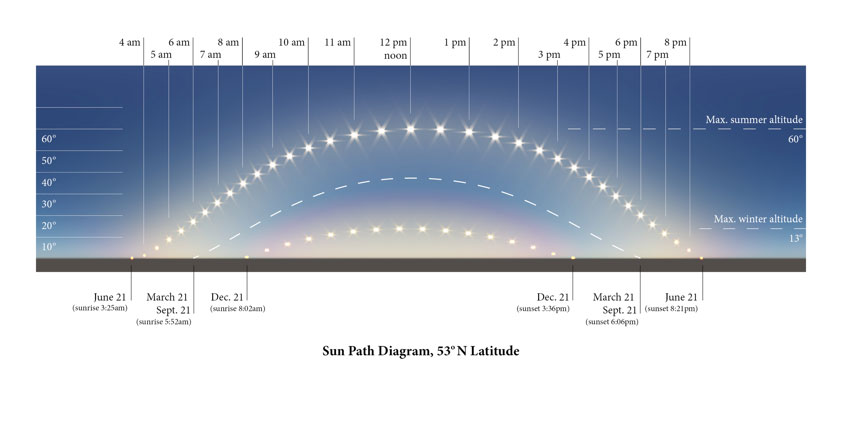
Thermochromic – Thermochromic glass is a passive technology that responds directly to heat from direct sunlight, which is similar to technology used in self-tinting glasses. It requires no electricity to operate. While this makes it simple to install and use, it is slow to respond to changing conditions, offers no flexibility, and cannot respond to individual user demands and changing lighting and HVAC needs. It may require the use of interior blinds for a specific application and may not be the best choice on all facades because reflected light will still cause glare. A window with a thermochromic glass laminate and low-E coating can have a visible light transmission between 54% and 8%, a solar heat gain coefficient from 0.36 and 0.16.
Obviously, thermochromic glass is limited to exterior applications. A good example of its use is (e.g. a building). http://www.commercialwindows.org/thermochromic.php
Polymer Dispersed Liquid Crystal – Collectively referred to as PDLC, this technology uses electricity to change the orientation of suspended liquid crystals, which either scatter light or let light pass through, depending on the voltage. PDLC switches nearly instantaneously and provides privacy. The downside to this technology is that not only is the clear state actually hazy but it also requires constant, high voltage electricity to stay “clear”— otherwise, it will turn opaque. The product is also susceptible to damage from solar/UV exposure, and there is little, if any, solar/heat control benefits. Consequently, PDLC is used primarily for interior applications, specifically, privacy on demand. Hotels are using it to separate glass bathroom walls from the sleeping area, the Éphelia Resort in the Seychelles is a good example. PDLC also comes in a variety of colors, and is available sandwiched within a glass, or as a film that can be attached to windows then connected by an electrical battery to make it work.
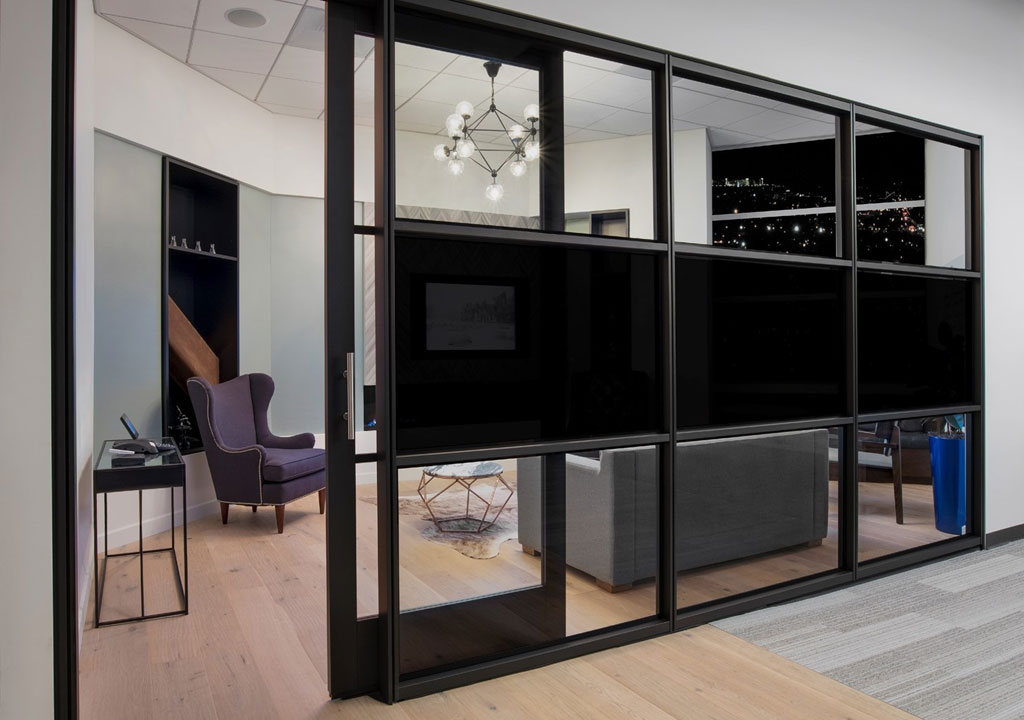
Credit: Kinestral Technologies
Suspended Particle Device (SPD)– This works similarly to PDLC in that in its static state, scattered, randomly -oriented microscopic particles block light, and when an electric charge is applied, the particles line up to allow light through for the glass to appear transparent. Unlike PDLC, you can tune the glass to a desired level of transparency. SPD glass tints quickly, within 1-3 seconds and blocks 99% of UV light, but like PDLC, it requires constant voltage to stay clear. In its tinted state, the glass is dark blue. SPD technology is viable and used in automobiles, though its historical complexity and high cost to manufacture as well as its cobalt blue tint state have limited its marketability in the building industry.
While SPD glass has some remote management and control functionality, it does not support Internet Protocol version 6 which is necessary to simplify integration, streamline building management and allow for future application development to make a building even smarter and greener over time.
Electrochromic – Electrochromic (EC) technologies can change state (clear or tinted) when exposed to an electrical charge. EC technologies actually absorb solar radiation, which make them great for controlling not just glare but also for eliminating solar heat transfer and blocking harmful UV rays. The advantages of EC are that it’s very durable, the tint state is controllable, and it can be operated at low voltages/power, as power is only used while it’s transitioning (0-10 volts). The control, durability, and energy efficiency have enabled EC to become an attractive solution for building owners.
In the past, the main drawbacks to EC technology are slow switching speeds (20-30 mins depending on the panel size), the transition can be non-uniform, switching from the outside-in to create an “iris” or “curtain” effect, and first generation EC products tend to have a yellowish clear state and a dark blue tinted state. That said, EC is the leading contender to make inroads to the massive building facade market because people love glass and natural light, but hate the glare.
Electrochromic technologies have been advanced in recent years in three key areas. Addressing the drawbacks of first generation EC, smart-tinting glass differs in three key areas:
- Switching speed – Smart-tinting glass starts tinting within 15 seconds and achieves its darkest tint in less than 3 minutes. That’s nearly 10 times the speed of earlier EC technologies. This makes this glass a good choice not only for windows that need to respond quickly to the movements of the sun, but also for conference rooms allowing the glass to darken and switch to presentation mode in less than 3 minutes.
- Color – In its clear state, smart-tinting glass is indistinguishable from conventional glass. It tints to neutral gray hues.
- Uniform tinting – Newer generation electrochromic technology tints so evenly that every shade in between clear and dark is usable. In fact, users can stop the tinting process when they get the shade they want.
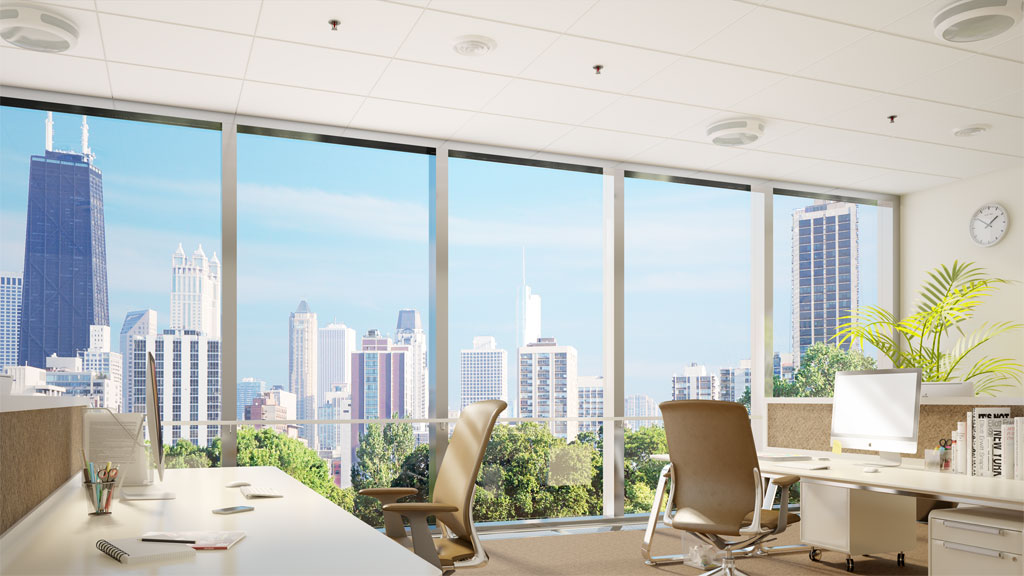
Office hi-rise before. Credit: Kinestral Technologies
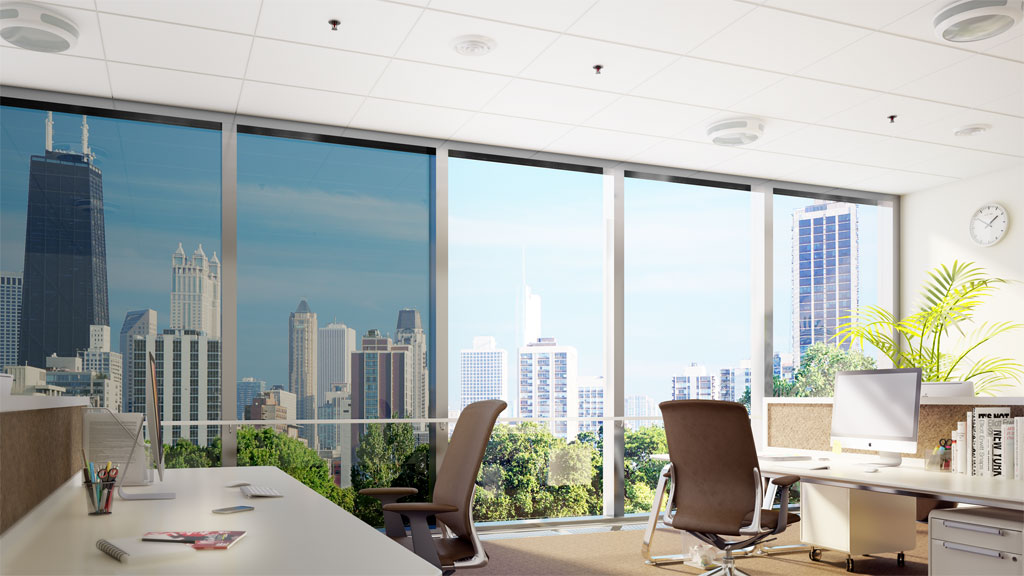
Office hi-rise after. Credit: Kinestral Technologies
Smart-tinting glass also uses smart home and building technology software Internet Protocol version 6, IPv6 for short, which allows the glass to connect directly to any Internet-connected device whether a computer, building system, or smart phone. With built-in Internet connectivity smart-tinting glass can communicate with and respond directly to building management software such as HVAC and lighting to balance temperature, ambient, and artificial light within an office throughout the day.
- Since each window has its own IPv6 address, this can be done on an office-by-office basis, whether the office is north- or south-facing, internal or external
- Interact with cloud technology which allows the glass to be securely controlled by anyone with the appropriate login credentials, from anywhere with any smart device.
- Future-proofs the glass to utilize up-and-coming and even yet to-be-developed building technologies.
- Allows it to take advantage of voice control technology.
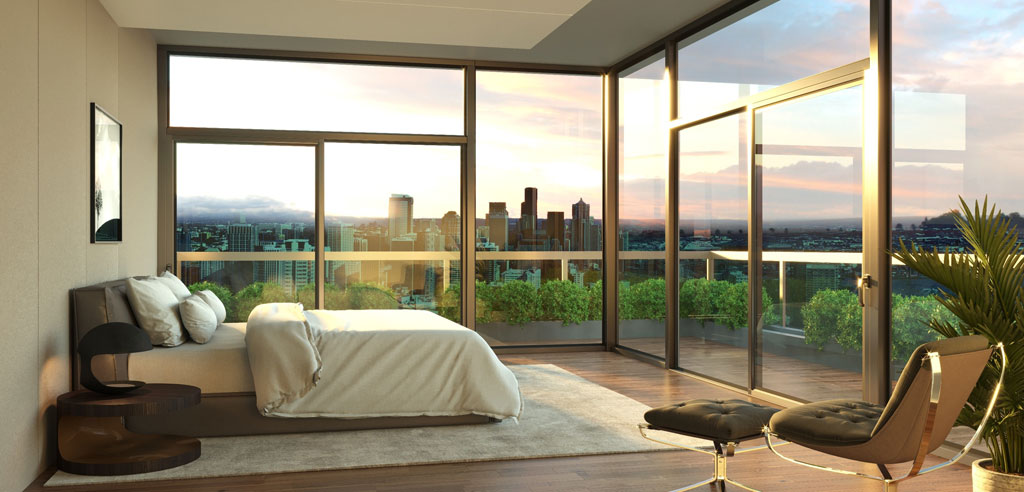
Bedroom sunrise clear. Credit: Kinestral Technologies
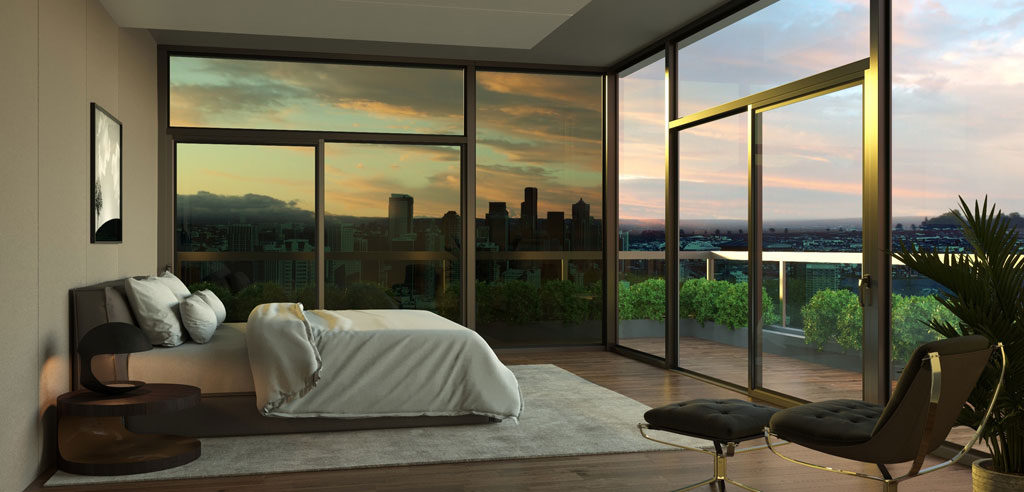
Bedroom sunrise tinted. Credit: Kinestral Technologies
Electrochromic has taken the lead in the market due to the inherent durability of the technology. You can expect EC windows and doors to last for decades. Typical EC windows have a clear state visible light transmittance in the range of 0.50–0.70 and a dark state visible light transmittance in the range of 0.001–0.03. The SHGC ranges from 0.09–0.50.
During the day, the low transmission is desirable for privacy and to control glare, eliminating the need for shades. A high transmission allows for more daylight to enter when the sun isn’t shining, or during the winter when passive solar heat is desirable.
One of the great benefits of the new energy-saving smart glass technologies is it allows architects to continue to design the “glassy” buildings people want while still adhering to more stringent energy regulations, such as California’s Title 24, which requires windows to adhere to a Solar Heat Gain Coefficient of .24. Smart-tinting glass comes in at a SHGC of 0.09, allowing for a greater glass to wall ratio, helping buildings qualify from BREAM, LEED and WELL certifications. With so many new window technologies to choose from, it’s become clear that the smart home or smart building can no longer earn a passing grade without smart glass windows and glass walls.
About the author
 Josh Hogan, vice-president of sales operations for Halio North America
Josh Hogan, vice-president of sales operations for Halio North America
Josh Hogan is vice-president of sales operations for Halio North America, the exclusive sales & service provider for Halio smart-tinting glass. Hogan holds degrees in mechanical engineering and a MBA from University of California Berkeley. Prior to Kinestral, he held global sales roles at Top 1 Oil Products and at ACCO Engineered Systems, working in the commercial construction industry.

